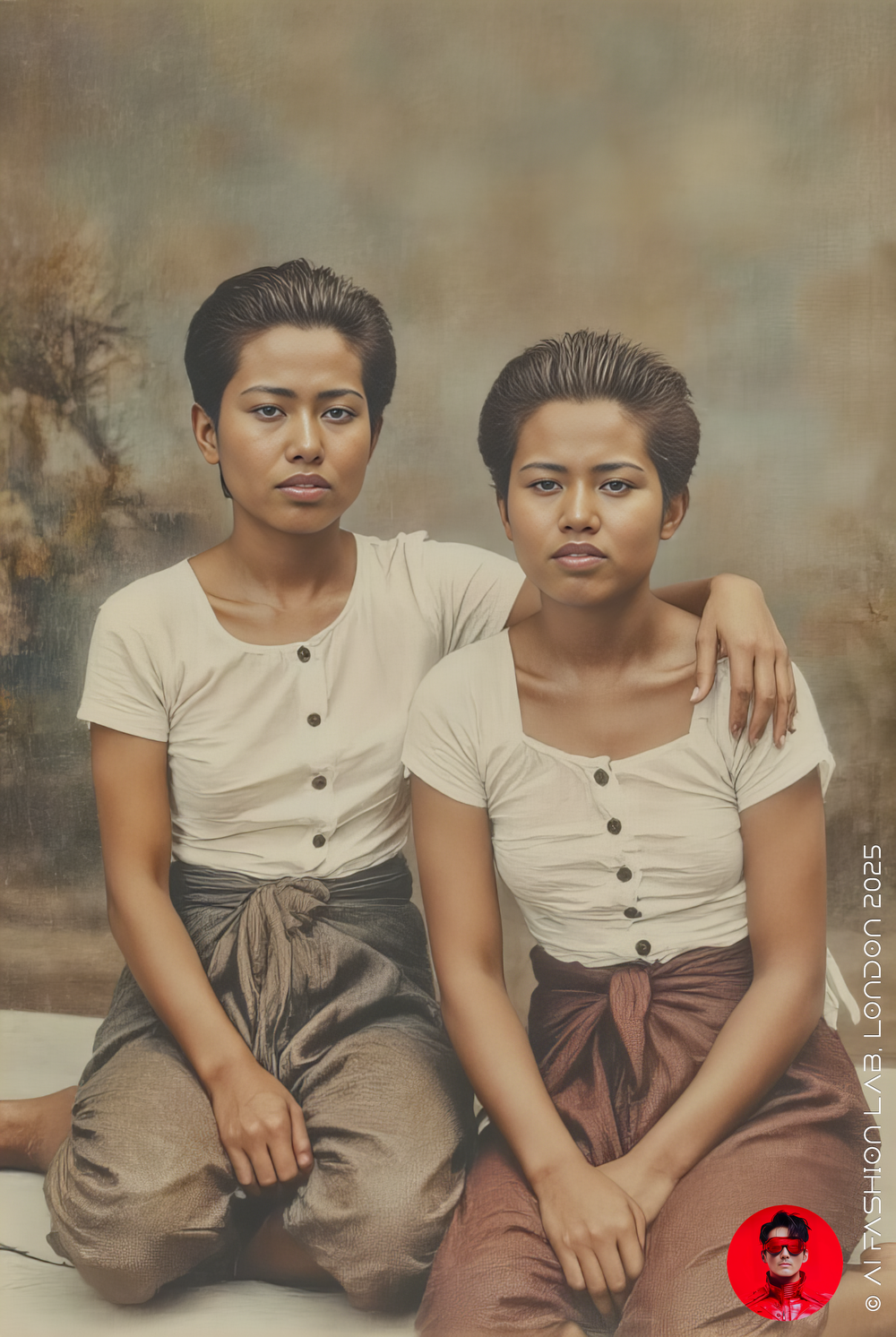เมื่อเสื้อชั้นในกลายเป็นเสื้อนอก: การปรับใช้เสื้อทับคอร์เซ็ตแบบตะวันตกในสยาม ในสมัยรัชกาลที่ ๕
เมื่อเสื้อชั้นในกลายเป็นเสื้อนอก: การปรับใช้เสื้อทับคอร์เซ็ตแบบตะวันตกในสยามปลาย ในสมัยรัชกาลที่ ๕
ในระหว่างที่ผมค้นคว้าเอกสารเพื่อเริ่มต้นการศึกษาระดับปริญญาเอกเมื่อหลายปีก่อน ณ กรุงลอนดอน ในหัวข้อวิจัยว่าด้วยประวัติศาสตร์แฟชั่นของสยามในรัชสมัยพระบาทสมเด็จพระจุลจอมเกล้าเจ้าอยู่หัว ผมได้ค้นพบชุดโปสการ์ดสมัยรัชกาลที่ ๕ ที่เก็บรักษาไว้ในหอจดหมายเหตุแห่งชาติ กรุงปารีส ภาพถ่ายเหล่านี้เป็นผลงานของช่างภาพชาวต่างชาติที่ประจำอยู่ในกรุงเทพฯ นามว่า J. Antonio ผู้มีบทบาทสำคัญในการบันทึกภาพชีวิตประจำวันของชาวสยามในช่วงเวลาดังกล่าว
ผลงานของ J. Antonio มีความโดดเด่นในการถ่ายทอดภาพของสามัญชนชาวกรุงเทพฯ ไม่ว่าจะเป็นหญิงชาย วัยรุ่น คนงาน หรือพ่อค้าแม่ค้า ซึ่งแตกต่างจากภาพถ่ายในยุคนั้นที่มักเน้นเฉพาะชนชั้นสูงหรือพระบรมวงศานุวงศ์ ภาพเหล่านี้จึงเป็นหลักฐานทางประวัติศาสตร์ที่สำคัญในการศึกษาแฟชั่นและวัฒนธรรมการแต่งกายของสยามในช่วงปลายคริสศตวรรษที่ 19
หนึ่งในภาพที่ผมพบและเป็นภาพที่น่าสนใจเป็นพิเศษ คือภาพของหญิงสาวชาวกรุงเทพฯ นั่งอยู่ในท่วงท่าสบาย ๆ นุ่งโจงกระเบนและเสื้อแขนสั้นกระชับลำตัว ติดกระดุมด้านหน้า และไว้ผมสั้นทรง "ดอกกระทุ่ม" ซึ่งเป็นที่นิยมในสมัยนั้น แต่เมื่อพิจารณาอย่างละเอียด ผมพบว่าเสื้อที่เธอสวมใส่คือ "เสื้อทับคอร์เซ็ต" (corset cover) ซึ่งเป็นเสื้อชั้นในของสตรีตะวันตกในยุควิกตอเรียน
กระบวนการการแต่งกายของสตรีตะวันตกในยุควิกตอเรียนมีการส่วมใส่เสื้อผ้าอย่างซับซ้อนเพื่อสะท้อนถึงความสุภาพเรียบร้อยและสถานะทางสังคม โดยเฉพาะชุดชั้นใน ซึ่งเริ่มจากเสื้อซับใน (chemise) ที่สวมติดผิวหนังเพื่อดูดซับเหงื่อและปกป้องร่างกาย ตามด้วยกางเกงชั้นใน (drawers) และสวมคอร์เซ็ตทับเสื้อเชอมิส ซึ่งช่วยจัดรูปทรงของร่างกาย หลังจากนั้นจึงสวมเสื้อทับคอร์เซ็ตอีกชั้นหนึ่งเพื่อปกปิดคอร์เซ็ตและเสริมความเรียบร้อยของเครื่องแต่งกายชั้นนอก
แม้เสื้อทับคอร์เซ็ตจะมีการตกแต่งด้วยลูกไม้หรือการปักลายอย่างสวยงาม แต่ในโลกตะวันตกในสมัยนั้น เสื้อทับคอร์เซ็ตถูกจัดว่าเป็นเสื้อชั้นในที่ไม่ควรเปิดเผยต่อสายตาผู้อื่น นักประวัติศาสตร์แฟชั่นอย่าง Carolyn Steedman ได้กล่าวถึงเสื้อชั้นในเหล่านี้ว่าเป็นทั้งเครื่องปกป้องร่างกายและเครื่องมือในการควบคุมวินัยและความประพฤติของสตรีในยุคนั้นอีกด้วย
การที่หญิงสาวชาวกรุงเทพฯ นำเสื้อทับคอร์เซ็ตมาใช้เป็นเสื้อนอกในชีวิตประจำวันนั้นสะท้อนให้เห็นถึงกระบวนการผสมผสานทางวัฒนธรรม (cultural hybridity) ซึ่ง Homi Bhabha อธิบายว่าเป็นกระบวนการที่เกิดขึ้นในบริบทอาณานิคมหรือหลังอาณานิคม ที่ซึ่งการเลียนแบบวัฒนธรรมของผู้มีอำนาจมิได้นำไปสู่การยอมจำนน แต่กลับเปิดพื้นที่ให้เกิดการตีความใหม่และสร้างอัตลักษณ์เฉพาะของตนเอง
แม้สยามจะไม่เคยตกเป็นอาณานิคมของชาติตะวันตก แต่ก็ได้รับอิทธิพลทางวัฒนธรรม เศรษฐกิจ และการเมืองจากมหาอำนาจเหล่านั้น ซึ่งนักมานุษยวิทยา Michael Herzfeld ได้เรียกสถานการณ์นี้ว่า "อาณานิคมอำพราง" (crypto-colonialism) กล่าวคือ การที่รัฐหนึ่งแม้จะไม่เคยตกอยู่ภายใต้การปกครองโดยตรงของเจ้าอาณานิคม แต่ก็ต้องดำเนินนโยบายหรือปรับเปลี่ยนวัฒนธรรมของตนเองให้สอดคล้องกับมาตรฐานตะวันตก
แนวคิด "กลยุทธ์ทางสุนทรียะแบบวิกตอเรียน" (Victorian acumen) ที่เสนอโดย Carol Breckenridge จึงเป็นกรอบที่เหมาะสมในการทำความเข้าใจปรากฏการณ์นี้ กล่าวคือ การเลือกสรรและปรับใช้สุนทรียะแบบวิกตอเรียนอย่างมีกลยุทธ์ของชนชั้นนำและประชาชนในสังคมอาณานิคมอำพราง มิได้เป็นเพียงการเลียนแบบ แต่เป็นการใช้แฟชั่นเป็นเครื่องมือในการต่อรองสถานะ ความรู้สึกสมัยใหม่ และอำนาจต่อรองกับโลกภายนอก
การที่เสื้อทับคอร์เซ็ต ซึ่งเป็นเสื้อชั้นในของสตรีตะวันตก กลายมาเป็นเสื้อนอกที่หญิงสาวชาวกรุงเทพฯ สวมใส่ในชีวิตประจำวันจึงมิใช่เพียงเรื่องของความสะดวกสบาย หากเป็นการประกาศความเป็นสมัยใหม่ในแบบฉบับของตนเอง เป็นการปรับใช้วัตถุที่มีความหมายเฉพาะในโลกตะวันตกให้เข้ากับภูมิอากาศ วัฒนธรรม และสุนทรียะแบบสยาม
เสื้อทับคอร์เซ็ตในบริบทนี้ยังสามารถมองได้ว่าเป็นต้นแบบของ "เสื้อคอกระเช้า" ซึ่งต่อมากลายเป็นเครื่องแต่งกายประจำบ้านของหญิงไทย โดยเฉพาะในบริบทชนบท เสื้อคอกระเช้ามีลักษณะคล้ายกับเสื้อทับคอร์เซ็ต ทั้งในด้านรูปแบบ การติดกระดุมด้านหน้า และความเรียบง่ายของการใช้งานในชีวิตประจำวัน
กรณีศึกษานี้ชี้ให้เห็นว่าแฟชั่นมิได้เป็นเพียงเรื่องของความงาม แต่ยังเป็นเครื่องมือในการสร้างอัตลักษณ์และการต่อรองทางวัฒนธรรม เสื้อผ้าที่เคยมีไว้เพื่อปกปิดกลับกลายมาเป็นเครื่องแสดงออกถึงความกล้าและความเป็นสมัยใหม่ในสยามที่กำลังเปลี่ยนผ่านเข้าสู่โลกสมัยใหม่อย่างชัดเจน
Undressing Modernity: The Siamese Appropriation of the Corset Cover as Outerwear in the Late 19th Century
During a recent exploration of historical imagery, I encountered a collection of 19th-century Siamese postcards preserved in the French national archives. These images, taken by the photographer J. Antonio, a Portuguese-Spanish commercial studio photographer based in Bangkok, offer a rare ethnographic lens into the daily life of ordinary Siamese people during the reign of King Chulalongkorn (Rama V). Antonio’s work diverged from the royal portraiture typically commissioned at the time, instead presenting vivid portraits of vendors, labourers, and women in everyday clothing—what anthropologist Christopher Pinney might call “vernacular photography” in the colonial contact zone.
Among these images, one particular portrait commands attention: a young woman of Bangkok, seated informally, wearing her hair in the “dok-kratum” cropped style then fashionable among working women. She is dressed in a chong kraben and a short-sleeved, buttoned blouse that—upon closer analysis—can be identified as a Victorian corset cover, a Western undergarment never intended for public display.
This image, seemingly mundane, is in fact profoundly revealing. It exemplifies what Arjun Appadurai terms the “production of locality” through objects and dress. The corset cover, once nested within the strict codification of Victorian sartorial layers, is here recontextualised as outerwear in a tropical, non-colonised kingdom negotiating modernity through selective Westernisation.
Victorian Undress: Modesty, Layering, and the Acumen of the Hidden
In late 19th-century Europe, women’s undergarments formed a meticulously structured system of propriety. The foundational layer was a chemise, followed by drawers, then the corset, which was laced to achieve the fashionable hourglass silhouette. To obscure the harsh lines of the corset and protect the outer bodice from wear, women wore corset covers, which ranged from sleeveless to cap-sleeved, often adorned with lace, embroidery, or pintucks. As seen in contemporary catalogues from H. O’Neill & Co. (1890–91) or B. Altman & Co. (1886–87), these items were constructed from lightweight white cotton or lawn, valued for their breathability and delicacy.
The corset cover, in Victorian society, signified modesty and propriety—a garment that "mediated the gaze" by shielding the body’s contour from exposure, even beneath additional layers. As Carolyn Steedman notes in her work on class and cleanliness, the undergarment was "both protective and disciplinary," shaping the moral body as much as the physical one.
Yet in the Bangkok postcard, this intimate garment has been reimagined entirely: now visible, frontal, and recontextualised as a lightweight outer blouse. This raises compelling questions about fashion adaptation, local agency, and the negotiation of Western modernity in Siam.
Fashioning the In-Between: Crypto-Colonialism and the Appropriation of Dress
Thailand (then Siam) famously avoided formal colonisation but did not escape what Michael Herzfeld has termed “crypto-colonialism”—the internalisation of colonial power structures through self-imposed Westernisation. In sartorial terms, this meant court dress reforms under King Chulalongkorn, the adoption of Western military uniforms, and the encouragement of European manners among elites. However, as this image reveals, adaptation was not confined to the palace. Ordinary Siamese women engaged in similar acts of sartorial hybridisation, albeit on their own terms.
The corset cover, when worn as outerwear, becomes a symbolic garment of crypto-colonial tension—a visual marker of modernity that does not follow the logic of European propriety but instead signals a localised reinterpretation of modern femininity. Rather than viewing this as mimicry, we might draw upon Homi Bhabha’s concept of “hybridity”, where imitation opens space for subversion, and colonial meanings are dislocated through everyday use.
This is echoed in Carol Breckenridge’s notion of “Victorian acumen”, where the performance of respectability and modernity in colonised (or semi-colonised) societies involves a tactical appropriation of Victorian aesthetic codes. For Breckenridge, such acts are not simple imitations but strategic selections, demonstrating an awareness of how global hierarchies are fashioned and performed through dress. The Bangkok woman in the postcard thus exhibits a sartorial literacy that cuts across cultural spheres, using a Western undergarment to articulate her modern subjecthood.
From Corset Cover to เสื้อคอกระเช้า: Local Innovation from Imported Form
This moment of appropriation did not pass into obscurity. The Victorian corset cover can be seen as a precursor to the Thai เสื้อคอกระเช้า (suea kho krachau)—a sleeveless or cap-sleeved blouse with front buttons, still widely worn in rural Thailand today. Like the corset cover, it is made from lightweight cotton, suitable for the climate, and signals informality and domesticity. That such a staple of Thai women's clothing could trace its genealogy to a Western undergarment speaks to the transformative potential of cross-cultural fashion.
Conclusion: Reading the Undergarment as Global Fashion Artifact
The case of the corset cover in Siam complicates simple East-West binaries in fashion history. It suggests a world in which local women actively chose, adapted, and redefined imported dress codes—not in blind imitation, but as strategic actors in a changing modern landscape. By turning the private into the public, the Bangkok girl in the photograph asserts her place in a new sartorial modernity, where the politics of dress are felt as intimately as they are visibly.
As we continue to trace the threads of fashion history, garments like the corset cover—once hidden beneath layers—re-emerge to tell stories of movement, modernity, and cultural negotiation.
#aifashionlab #AI #aiartist #aiart #aifashion #aifashiondesign #aifashionstyling #aifashiondesigner #fashion #fashionhistory #historyoffashion #fashionstyling #fashionphotography #digitalfashion #digitalfashiondesign #digitalcostumedesign #digitaldesign #digitalaiart #ThaiFashionHistory #ThaiFashionAI #flux #kreaflux #kreatraining




































































